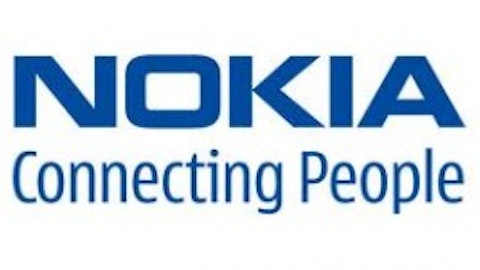eBay Inc (NASDAQ:EBAY) is the premier online commerce company. Individuals and businesses can list items for auction or at “Buy It Now” prices, and consumers buy the products, sometimes brand new and other times in used condition. It’s a very simple and easy to understand business, as every time a seller lists a product, eBay gets to charge a transaction fee. With 112 million active users and more than 350 million listings globally, eBay is a solid company.
Competitive advantage

Other e-commerce plays have a tough time competing with eBay. For instance, there must be a link between two people in order for the business to work (a buyer and a seller), and it’s almost impossible to establish such a network when eBay’s business already works seamlessly.
Even if I had $1 billion, I couldn’t compete with eBay. That’s because the company’s advantage isn’t measured in monetary terms but instead in people, and it’s that trust and loyalty that gives eBay a huge moat.
Amazon’s model is more of a store front, much like Wal-Mart Stores, Inc. (NYSE:WMT). The difference between Amazon, Wal-Mart, and eBay is that eBay doesn’t actually sell anything, whereas the other two do.
In addition, Amazon.com, Inc. (NASDAQ:AMZN) and Wal-Mart sell significantly fewer products than eBay (think of the items and services sold by individual people that aren’t sold in stores.) Although Amazon and Wal-Mart Stores, Inc. (NYSE:WMT) are tough competitors, they can’t match eBay’s advantage of connecting two people for a transaction.
Growth opportunities
eBay Inc (NASDAQ:EBAY) has a lot of opportunities to grow. First, with an already superior network, more people looking to sell and buy products will use eBay to gain access to millions of others who are similarly looking to buy or sell said products. With more people using eBay, this means more listings and more revenue for eBay.
In addition, eBay’s PayPal service is growing in the mobile arena, allowing consumers to pay just by entering an email and password, or via Near Field Communication (NFC) technology found on some newer phones.
eBay gets a small cut when a transaction is made through PayPal. With the rise of eBay’s network effect and mobile payments, eBay still has plenty of room to grow.
Management
eBay Inc (NASDAQ:EBAY) has a great management team. Pierre Omidyar founded the company in 1995 and has been chairman since its incorporation. He also owns 121 million shares, or 9.4% of the company, and is eBay’s largest shareholder.
It’s always great to see a company’s founder still at the helm — especially as the largest shareholder. With Pierre having much of his future tied to eBay’s performance, he’ll ensure the company matures well over time.
eBay’s CEO is John Donahoe, who owns about 400,000 shares as well as 2.8 million options that expire in May. Donahoe has been CEO for about five years and earns just under $1 million in base salary. When you add in a $2.8 million bonus and millions of dollars more in stock grants, his total compensation comes out to $29.7 million.
If that makes you cringe, know that 70% of his total compensation is tied to his performance (and since the company did well last year his pay is somewhat higher than usual).
I find that his huge paycheck is reasonable because if the company starts to decline, so will his bonus, and I am perfectly fine with that. Shares outstanding have been consistent at 1.3 billion, and while the company hasn’t repurchased any shares, it also hasn’t been diluting shareholders’ positions.
Financial analysis
To recap before heading into the numbers, eBay Inc (NASDAQ:EBAY) has a wide moat with many growth opportunities and has a management team that is heavily invested in the success of the company. As a result, I believe that eBay can be a great investment. Let’s look at the numbers to see just how awesome eBay is.
Since 2008, eBay’s sales have increased 64% and net income has increased by 46%.
The cost of goods sold has stayed the same at around 30% of sales. This means that costs aren’t increasing but they’re not decreasing, either, so eBay can’t squeeze profits by cutting costs. It will have to rely on selling more instead of cutting costs.
Net margins have approximately been in the mid-20% range for the past couple of years, which is more than double the industry average.
Return on invested capital is around 14% for the past five years
Equity (or book value) has been increasing around 16% for the past five years
Cash flow from operations has been increasing every year, with a 7% increase from four years ago and a 17% increase from last year.
Free cash flow has also been increasing, growing 3% from four years ago to 12% last year.
Free cash flow/sales decreased 22% four years ago and fell 18% last year. With such a high FCF/sales rate, however, the decline shouldn’t cause investors to shy away. If eBay was reporting 5% FCF/sales and it was decreasing, then I’d start to get nervous. But with 20% of every dollar turning into free cash, I’m content with that.
The return on equity averages to 16% for the past five years, about 3% above the industry average.
Return on assets averages to 11% for the past five years, meaning for every dollar of assets eBay returns 11% on average as net income.
eBay has $4.1 billion in long-term debt, which can be paid off using free cash flow in two years (if it had to). eBay’s debt-to-equity ratio is 0.2, which is reasonable. Although I like companies that have very little or no debt, eBay does a responsible job of managing its debt, and can pay it off if it had to.
All of those metrics are great. Management must be doing something right to produce those stellar numbers. I’m really excited about eBay and it seems to be a great company to own, but only at the right price.
Competition with Amazon.com, Inc. (NASDAQ:AMZN)
Amazon has increased its sales by over 200% since 2008, which is a far better showing than eBay Inc (NASDAQ:EBAY). However, Amazon’s cost of goods sold (COGS) is at a staggering 80%, meaning that for every dollar Amazon makes, it must spend $0.80.
This results in a negative net income for Amazon, not something that’s attractive when investing in a company. Investors are betting that eventually Amazon will turn positive and reward shareholders, but so far Amazon hasn’t done that. Even though the company is doing many great things, I’d stay away from the stock until Amazon increases shareholder value.
Competition with Wal-Mart Stores, Inc. (NYSE:WMT)
Since 2008, Wal-Mart has increased sales by 17% and net income by 28%. In 2012, 75% of sales went to COGS, and net margins came to 4%. For every dollar Wal-Mart made, only $0.04 became profit.
There is growth at Wal-Mart, but it’s much slower than eBay Inc (NASDAQ:EBAY)’s growth. Wal-Mart still has huge COGS and it has stayed at 75% for the past five years, meaning that the company isn’t cutting costs.
Wal-Mart is a good long-term dividend paying stock, and a safe buy for long-term investors. However, there seems to be greater growth opportunities in eBay than with Wal-Mart.
Valuation
Using all these numbers as a guide, I’ll estimate that eBay Inc (NASDAQ:EBAY) will grow around 15% for the next five years. Using the current EPS of $1.99 and the average PE of 16 over the last five years as the baseline, in five years eBay’s stock price should be around $64.
Buying the stock today at $55 would represent a 3% gain in five years. Since I personally would like a higher return on my investment, I’ll wait for the stock to drop to around $40, which will represent a 10% gain. Further, I would need some sort of margin of safety, let’s say a 20% cushion, resulting in a buy price of around $30.
Right now, eBay is valued for little growth if it keeps on the same path as it has traversed for the past couple of years. Wall Street is pricing the stock with hopes of huge gains in the mobile space and e-commerce in general. If eBay misses earnings by a penny or if the market reacts to some unimportant news, it may be our chance to buy the stock.
eBay has proven to be a consistent money-machine and it still has plenty of room to grow. Wait for a pullback for a near-sighted event (like a miss in quarterly earnings estimates) to get the stock at a price poised for gains.
Risks
Let’s look at some of the risks with possibly investing in eBay. One of the biggest factors relating to eBay’s business is the economy. If another recession hits like the one in 2008, very few people will have the disposable income to buy products on eBay and sellers will stop listing items because of low demand, resulting in lower revenue.
In addition, customers have other options to buy similar products on Amazon.com, Inc. (NASDAQ:AMZN) and Wal-Mart Stores, Inc. (NYSE:WMT), as well as using sites like Google Inc (NASDAQ:GOOG) Shopping and Microsoft Corporation (NASDAQ:MSFT)’s Bing Shopping to compare prices among different sites.
Personally, I think eBay’s biggest threat is new items sold by Amazon and Wal-Mart. eBay dominates the used items market, and although the other two stores do sell used goods, eBay’s auction price model allows for cheaper prices for consumers. Furthermore, eBay’s rating system for sellers provides a clear way for consumers to decide if the seller is a good one, combating Amazon’s and Wal-Mart’s stellar reputations.
The bottom line
eBay Inc (NASDAQ:EBAY) has a large competitive advantage with its network effect of trusted buyers and sellers. There is plenty of room to grow with increasing online and mobile sales as well as other initiatives, like eBay’s same-day delivery service. Management has been around for many years and is heavily invested in the future of the company, and most of the financial analysis points to a growing business that is properly managed.
I would buy a very small position in eBay now (just because of the stellar financial numbers), but wait for future pullbacks to invest more, with the expectation that if the price drops to $30 to invest much more heavily.
eBay Inc (NASDAQ:EBAY) does have some risks, but as long as it keeps the network of buyers and sellers, as well as continues developing the website, brand, and mobile payment options, eBay can compete with the likes of Amazon and Wal-Mart Stores, Inc. (NYSE:WMT).
Alec Eiber owns shares of Wal-Mart Stores. The Motley Fool recommends Amazon.com and eBay. The Motley Fool owns shares of Amazon.com and eBay.




